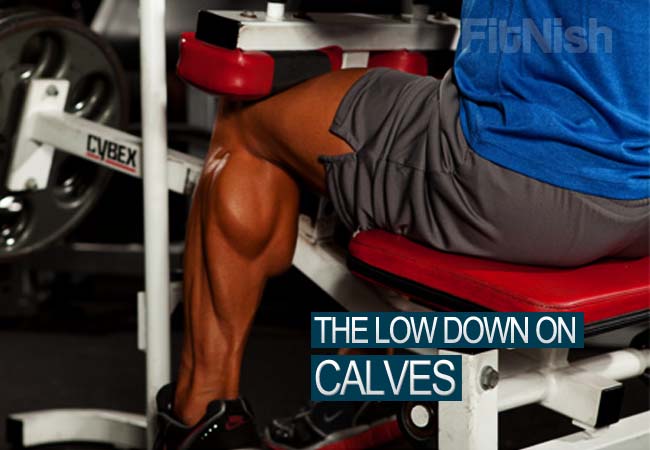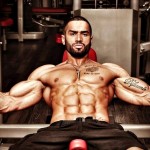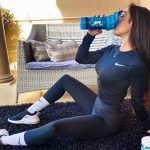
Look at those guns! The biceps flexing and those ripped triceps. Something we hear so often when someone refers to a guy with perfectly formed biceps and triceps or ‘ARMS’. Having a good pair of guns does seem impressive, and yes, it takes a lot of work to get them, and you can wear the perfect shirt to make sure you can see them from the moon, but let me tell you this,
“if you want perfect balance of symmetry throughout your entire physique, you need the calves to match those guns.”
When I think of calves, I think of how it was the one weakness of Arnold Schwarzenegger and he had to work for it. Also what springs to most people’s minds is the saying, ”if you are not born with calves you will never have them”. This is the last thing that comes to my mind when I think of calves and the modern bodybuilders with massive calves.
Lets first look at the anatomy of the calf muscles.
Here are the 3 major muscle groups of the lower leg:

Gastrocnemius
This is the largest calf muscle and the one that most people work. This is the one that you see when flexing and looking down at your calves.
Standing calf raise exercises, donkey calf raises, and all variations of those two calf muscle exercises will work the large gastrocnemius muscle. If the leg is not bent, the gastrocnemius is being worked.
Soleus
The soleus is another large calf muscle. If you looked at someone’s calves as you were standing behind them, you would see the soleus muscles running down both sides of the lower leg.
The soleus gives the calves depth and thickness because the soleus lies beneath the larger gastrocnemius muscle.
The soleus is worked during calf muscle exercises in which the knee is bent. So any variation of seated calf raises or squat raises will work the soleus.
Tibialis Anterior
The tibialis anterior is almost always ignored. It’s the huge frontal muscle that you can see if you flex your toe upwards and watch the area below the front part of your knee.
This muscle goes all the way down the front part of your lower leg. If you haven’t been working your tibialis anterior, you’ve been missing out!
Reverse calf raises of any type will work the tibialis anterior.

“If you want to build the calves to their fullest potential, you MUST include calf exercises that work each of the 3 major muscle groups listed above.”
Now boys (and girls), I know it is easy to wear a pair of jeans to cover up and forget about the toothpicks you call legs, but a proper size quad with a rounding hamstring flowing down into a well built calf, attracts more attention and respect than the guns bulging out of the shirt you bought in the kiddies section at your local clothing store. Now let’s see how I can help you get those calves bigger than ever and the respect they need.
I will discuss calf training using the following criteria:
- Frequency
- Sets and reps
- Rest
- Exercises
1. Frequency
How often should I train my Calves? The calf muscle is like all other muscles, and needs 48 hours to recover after a hard session. In that 48 hours of rest the muscle gets time to recover from the workout, to grow and to prepare for the next workout. I suggest that you work on the clock, count down the 48 hours and then hit the calves hard again.
“Do the calves at the beginning of your session, while you are still fresh and concentrating.”
Leaving calves to the end of your workout often leads to you not giving them enough attention.
2. Sets and reps
How many sets and reps should I perform with each calf workout?
“All you need is at least 20 sets per calf workout to ensure it gets a full workout. Concentrate on each rep, stretching the calves to their limits, going onto the toe with a slow controlled pace. At the top of the movement squeeze your calves a little higher and harder and then slowly with control bring them down, stretching the calf down as far as you can go, this is one rep.”
Now counting reps is easy, do 15 reps and stop, easy yes, stimulating the calves not by far. The best bit of advice I got for calf training was, you start with your calf exercise, stretching it and then pushing it, rep after rep, then when that beautiful burning sensation hits the calves, that is when you start counting one, two, three, you keep on counting till your training partner makes the call that your movement is too small to be counted as a rep. That will be one set done, 19 sets like that to go.
3. Rest
How long should I rest between sets? The golden rule of resting 30-45 seconds between sets for mass building is still considered the Holy Grail.
4. Exercises
What are the best exercises to do? All calf training exercises are the best to do to stimulate the muscle with as many different exercises as you can.
Gastrocnemius (Exercises with knees straight)
- Standing Calf Raise
- Donkey Calf Raise
Soleus (Exercises with knees bent)
- Seated Calf Raise
- Squat Raise
Tibialis Anterior Exercises
- Reverse Calf Raise

There you have it, go train and get the calves you always wanted, the calves you need to match your guns and to give you that perfect symmetrical physique. Remember that with all the hard training you put in, you need to eat to gain size;
“Nutrition and training together will give you the size you are looking for.”
Author: Flippie Van Schalkwyk
About the Author: Flippie is a Certified Personal Trainer with a BA degree in Human Movement Science (Univ. of Pretoria) and has over 10 years Personal Training experience.
Author Profile: Read more about Flippie Van Schalkwyk













